CADILLAC STS 2009 1.G Owners Manual
Manufacturer: CADILLAC, Model Year: 2009, Model line: STS, Model: CADILLAC STS 2009 1.GPages: 514, PDF Size: 2.73 MB
Page 341 of 514
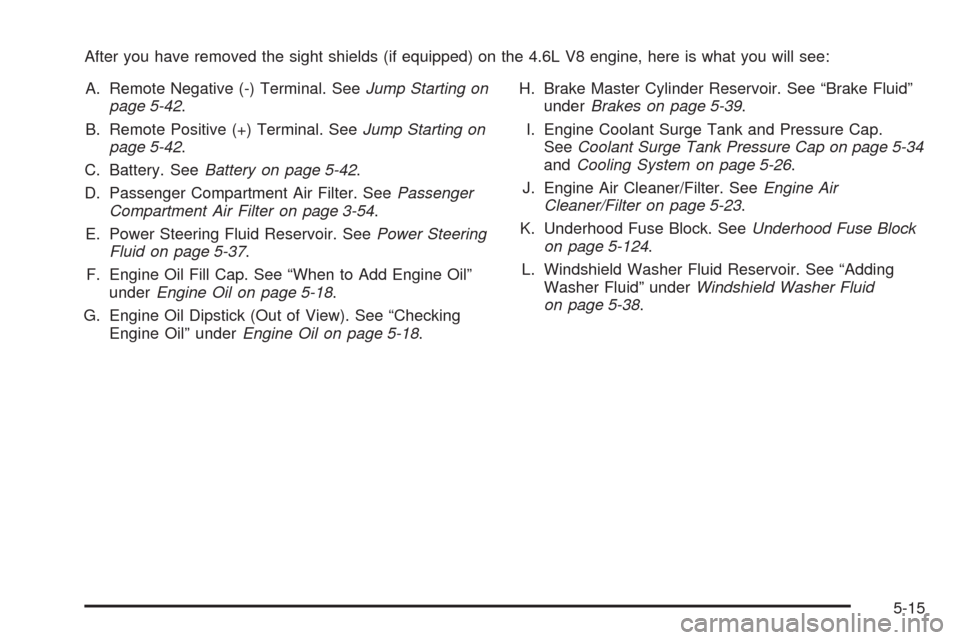
After you have removed the sight shields (if equipped) on the 4.6L V8 engine, here is what you will see:
A. Remote Negative (-) Terminal. SeeJump Starting on
page 5-42.
B. Remote Positive (+) Terminal. SeeJump Starting on
page 5-42.
C. Battery. SeeBattery on page 5-42.
D. Passenger Compartment Air Filter. SeePassenger
Compartment Air Filter on page 3-54.
E. Power Steering Fluid Reservoir. SeePower Steering
Fluid on page 5-37.
F. Engine Oil Fill Cap. See “When to Add Engine Oil”
underEngine Oil on page 5-18.
G. Engine Oil Dipstick (Out of View). See “Checking
Engine Oil” underEngine Oil on page 5-18.H. Brake Master Cylinder Reservoir. See “Brake Fluid”
underBrakes on page 5-39.
I. Engine Coolant Surge Tank and Pressure Cap.
SeeCoolant Surge Tank Pressure Cap on page 5-34
andCooling System on page 5-26.
J. Engine Air Cleaner/Filter. SeeEngine Air
Cleaner/Filter on page 5-23.
K. Underhood Fuse Block. SeeUnderhood Fuse Block
on page 5-124.
L. Windshield Washer Fluid Reservoir. See “Adding
Washer Fluid” underWindshield Washer Fluid
on page 5-38.
5-15
Page 342 of 514
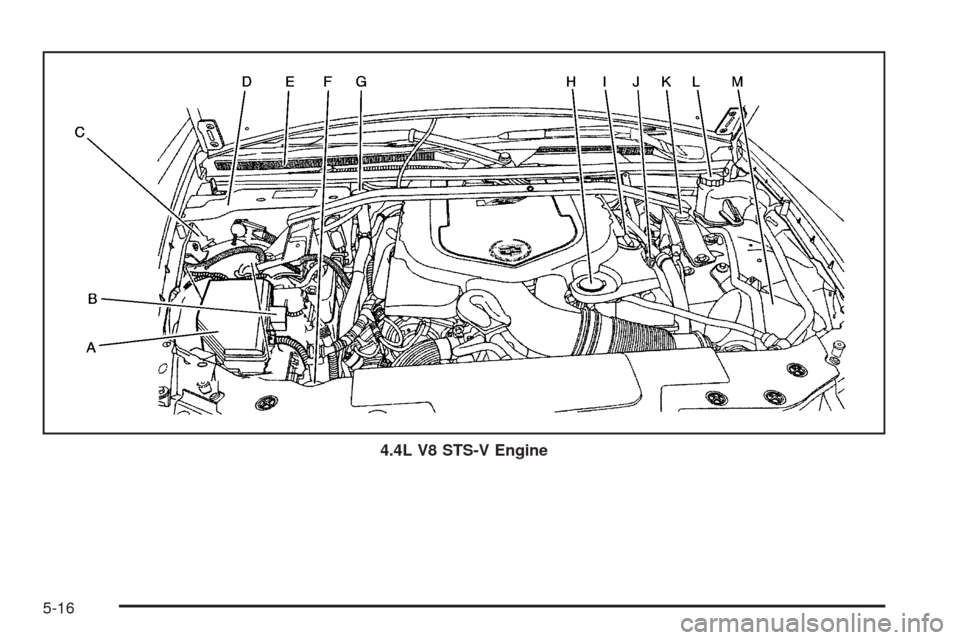
4.4L V8 STS-V Engine
5-16
Page 343 of 514
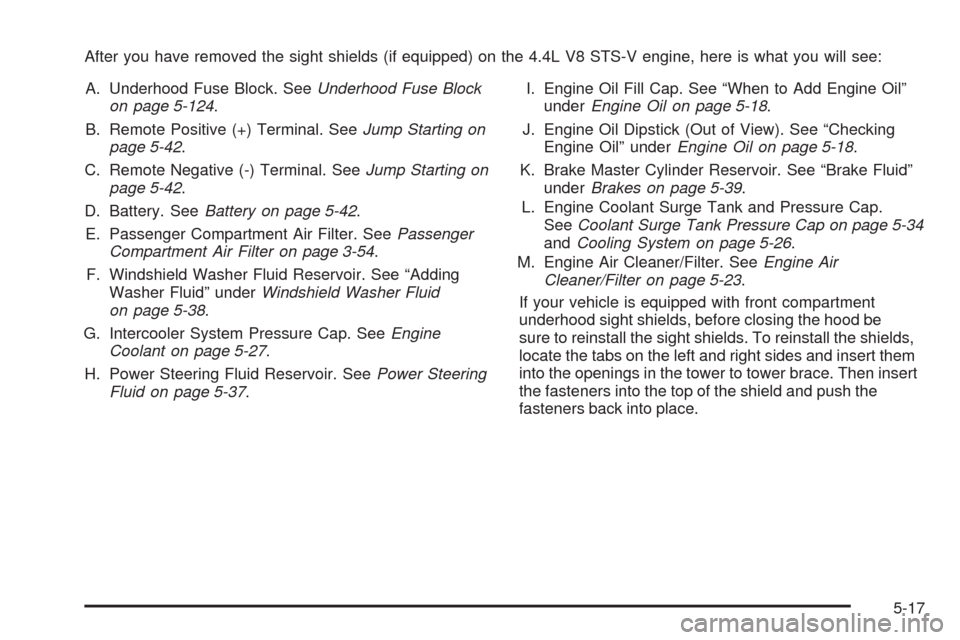
After you have removed the sight shields (if equipped) on the 4.4L V8 STS-V engine, here is what you will see:
A. Underhood Fuse Block. SeeUnderhood Fuse Block
on page 5-124.
B. Remote Positive (+) Terminal. SeeJump Starting on
page 5-42.
C. Remote Negative (-) Terminal. SeeJump Starting on
page 5-42.
D. Battery. SeeBattery on page 5-42.
E. Passenger Compartment Air Filter. SeePassenger
Compartment Air Filter on page 3-54.
F. Windshield Washer Fluid Reservoir. See “Adding
Washer Fluid” underWindshield Washer Fluid
on page 5-38.
G. Intercooler System Pressure Cap. SeeEngine
Coolant on page 5-27.
H. Power Steering Fluid Reservoir. SeePower Steering
Fluid on page 5-37.I. Engine Oil Fill Cap. See “When to Add Engine Oil”
underEngine Oil on page 5-18.
J. Engine Oil Dipstick (Out of View). See “Checking
Engine Oil” underEngine Oil on page 5-18.
K. Brake Master Cylinder Reservoir. See “Brake Fluid”
underBrakes on page 5-39.
L. Engine Coolant Surge Tank and Pressure Cap.
SeeCoolant Surge Tank Pressure Cap on page 5-34
andCooling System on page 5-26.
M. Engine Air Cleaner/Filter. SeeEngine Air
Cleaner/Filter on page 5-23.
If your vehicle is equipped with front compartment
underhood sight shields, before closing the hood be
sure to reinstall the sight shields. To reinstall the shields,
locate the tabs on the left and right sides and insert them
into the openings in the tower to tower brace. Then insert
the fasteners into the top of the shield and push the
fasteners back into place.
5-17
Page 344 of 514
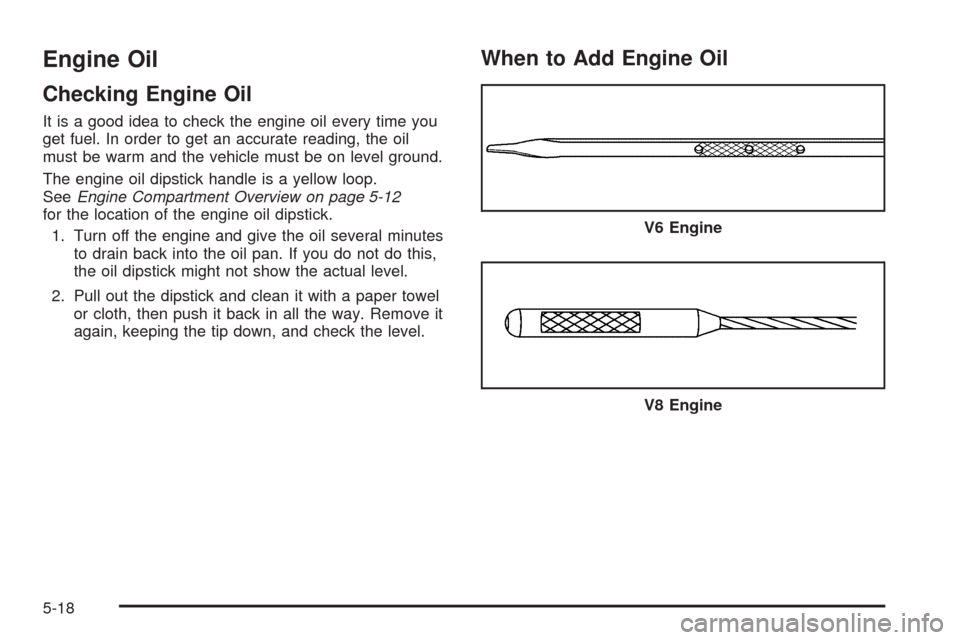
Engine Oil
Checking Engine Oil
It is a good idea to check the engine oil every time you
get fuel. In order to get an accurate reading, the oil
must be warm and the vehicle must be on level ground.
The engine oil dipstick handle is a yellow loop.
SeeEngine Compartment Overview on page 5-12
for the location of the engine oil dipstick.
1. Turn off the engine and give the oil several minutes
to drain back into the oil pan. If you do not do this,
the oil dipstick might not show the actual level.
2. Pull out the dipstick and clean it with a paper towel
or cloth, then push it back in all the way. Remove it
again, keeping the tip down, and check the level.
When to Add Engine Oil
V6 Engine
V8 Engine
5-18
Page 345 of 514
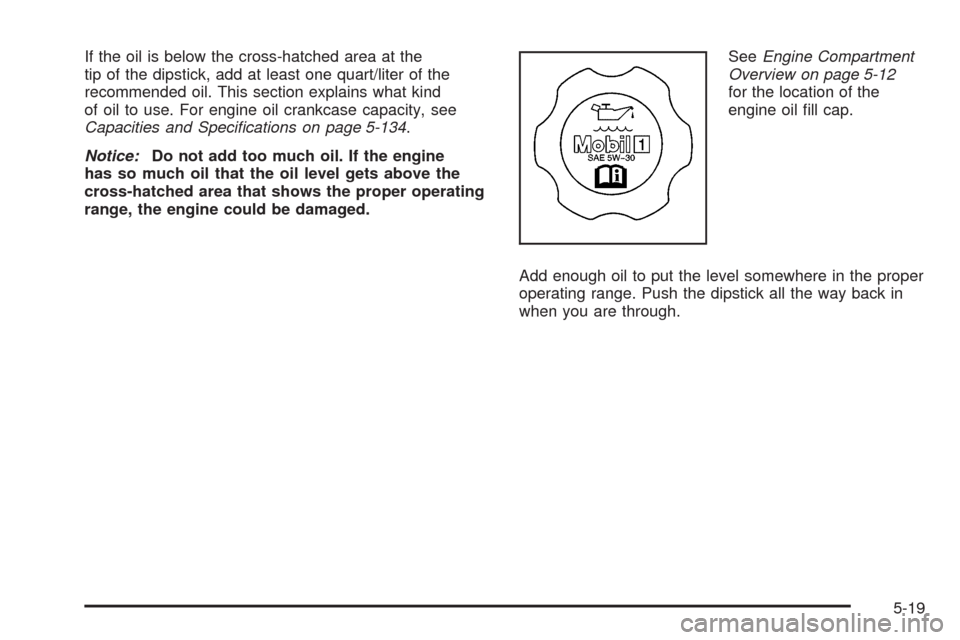
If the oil is below the cross-hatched area at the
tip of the dipstick, add at least one quart/liter of the
recommended oil. This section explains what kind
of oil to use. For engine oil crankcase capacity, see
Capacities and Specifications on page 5-134.
Notice:Do not add too much oil. If the engine
has so much oil that the oil level gets above the
cross-hatched area that shows the proper operating
range, the engine could be damaged.SeeEngine Compartment
Overview on page 5-12
for the location of the
engine oil �ll cap.
Add enough oil to put the level somewhere in the proper
operating range. Push the dipstick all the way back in
when you are through.
5-19
Page 346 of 514
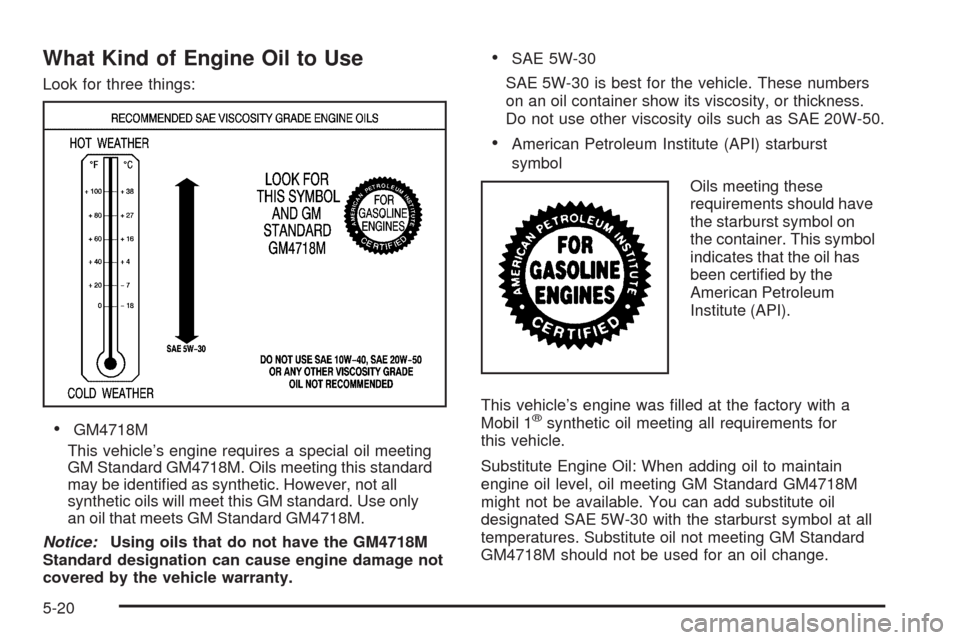
What Kind of Engine Oil to Use
Look for three things:
GM4718M
This vehicle’s engine requires a special oil meeting
GM Standard GM4718M. Oils meeting this standard
may be identi�ed as synthetic. However, not all
synthetic oils will meet this GM standard. Use only
an oil that meets GM Standard GM4718M.
Notice:Using oils that do not have the GM4718M
Standard designation can cause engine damage not
covered by the vehicle warranty.
SAE 5W-30
SAE 5W-30 is best for the vehicle. These numbers
on an oil container show its viscosity, or thickness.
Do not use other viscosity oils such as SAE 20W-50.
American Petroleum Institute (API) starburst
symbol
Oils meeting these
requirements should have
the starburst symbol on
the container. This symbol
indicates that the oil has
been certi�ed by the
American Petroleum
Institute (API).
This vehicle’s engine was �lled at the factory with a
Mobil 1
®synthetic oil meeting all requirements for
this vehicle.
Substitute Engine Oil: When adding oil to maintain
engine oil level, oil meeting GM Standard GM4718M
might not be available. You can add substitute oil
designated SAE 5W-30 with the starburst symbol at all
temperatures. Substitute oil not meeting GM Standard
GM4718M should not be used for an oil change.
5-20
Page 347 of 514
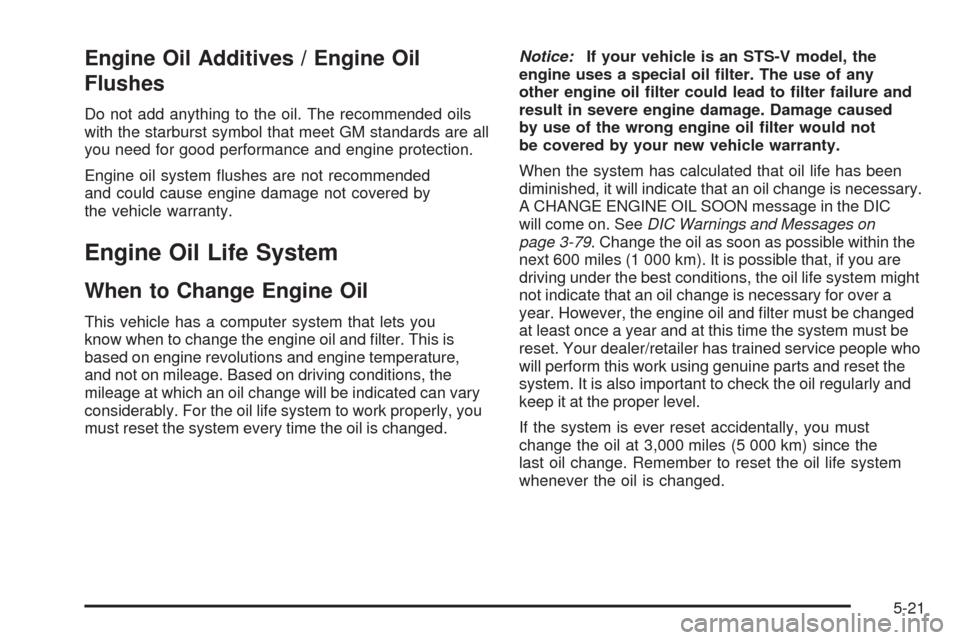
Engine Oil Additives / Engine Oil
Flushes
Do not add anything to the oil. The recommended oils
with the starburst symbol that meet GM standards are all
you need for good performance and engine protection.
Engine oil system �ushes are not recommended
and could cause engine damage not covered by
the vehicle warranty.
Engine Oil Life System
When to Change Engine Oil
This vehicle has a computer system that lets you
know when to change the engine oil and �lter. This is
based on engine revolutions and engine temperature,
and not on mileage. Based on driving conditions, the
mileage at which an oil change will be indicated can vary
considerably. For the oil life system to work properly, you
must reset the system every time the oil is changed.Notice:If your vehicle is an STS-V model, the
engine uses a special oil �lter. The use of any
other engine oil �lter could lead to �lter failure and
result in severe engine damage. Damage caused
by use of the wrong engine oil �lter would not
be covered by your new vehicle warranty.
When the system has calculated that oil life has been
diminished, it will indicate that an oil change is necessary.
A CHANGE ENGINE OIL SOON message in the DIC
will come on. SeeDIC Warnings and Messages on
page 3-79. Change the oil as soon as possible within the
next 600 miles (1 000 km). It is possible that, if you are
driving under the best conditions, the oil life system might
not indicate that an oil change is necessary for over a
year. However, the engine oil and �lter must be changed
at least once a year and at this time the system must be
reset. Your dealer/retailer has trained service people who
will perform this work using genuine parts and reset the
system. It is also important to check the oil regularly and
keep it at the proper level.
If the system is ever reset accidentally, you must
change the oil at 3,000 miles (5 000 km) since the
last oil change. Remember to reset the oil life system
whenever the oil is changed.
5-21
Page 348 of 514
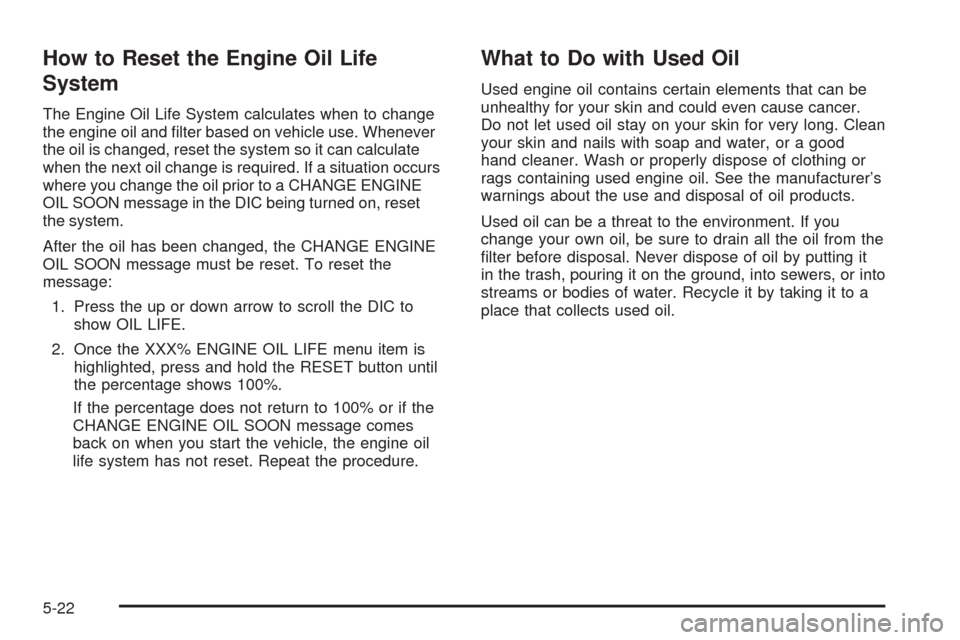
How to Reset the Engine Oil Life
System
The Engine Oil Life System calculates when to change
the engine oil and �lter based on vehicle use. Whenever
the oil is changed, reset the system so it can calculate
when the next oil change is required. If a situation occurs
where you change the oil prior to a CHANGE ENGINE
OIL SOON message in the DIC being turned on, reset
the system.
After the oil has been changed, the CHANGE ENGINE
OIL SOON message must be reset. To reset the
message:
1. Press the up or down arrow to scroll the DIC to
show OIL LIFE.
2. Once the XXX% ENGINE OIL LIFE menu item is
highlighted, press and hold the RESET button until
the percentage shows 100%.
If the percentage does not return to 100% or if the
CHANGE ENGINE OIL SOON message comes
back on when you start the vehicle, the engine oil
life system has not reset. Repeat the procedure.
What to Do with Used Oil
Used engine oil contains certain elements that can be
unhealthy for your skin and could even cause cancer.
Do not let used oil stay on your skin for very long. Clean
your skin and nails with soap and water, or a good
hand cleaner. Wash or properly dispose of clothing or
rags containing used engine oil. See the manufacturer’s
warnings about the use and disposal of oil products.
Used oil can be a threat to the environment. If you
change your own oil, be sure to drain all the oil from the
�lter before disposal. Never dispose of oil by putting it
in the trash, pouring it on the ground, into sewers, or into
streams or bodies of water. Recycle it by taking it to a
place that collects used oil.
5-22
Page 349 of 514
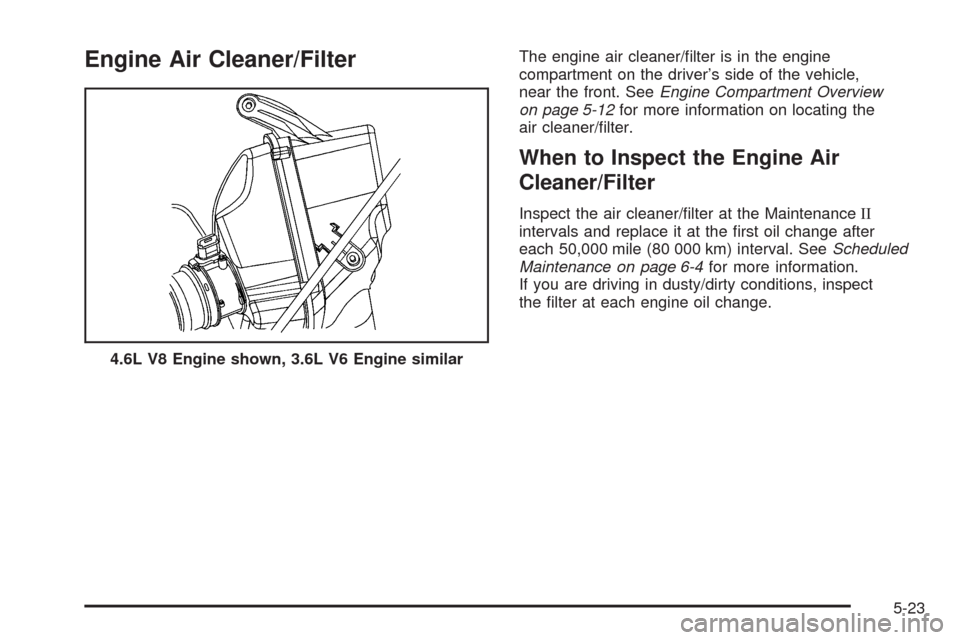
Engine Air Cleaner/FilterThe engine air cleaner/�lter is in the engine
compartment on the driver’s side of the vehicle,
near the front. SeeEngine Compartment Overview
on page 5-12for more information on locating the
air cleaner/�lter.
When to Inspect the Engine Air
Cleaner/Filter
Inspect the air cleaner/�lter at the MaintenanceII
intervals and replace it at the �rst oil change after
each 50,000 mile (80 000 km) interval. SeeScheduled
Maintenance on page 6-4for more information.
If you are driving in dusty/dirty conditions, inspect
the �lter at each engine oil change.
4.6L V8 Engine shown, 3.6L V6 Engine similar
5-23
Page 350 of 514

How to Inspect the Engine Air
Cleaner/Filter
To inspect the air cleaner/�lter remove the �lter from the
vehicle and lightly shake the �lter to release loose dust
and dirt. If the �lter remains caked with dirt, a new �lter
is required.
To inspect or replace the �lter in the 3.6L V6 or
4.6L V8 engines, do the following:
1. Remove the two screws located on the top of
the cover.
2. Disconnect the coolant recovery hose so that
it is not going across the top of the engine air
cleaner/�lter.
3. Loosen the clamp and remove the duct from the
passenger’s side of the engine air cleaner/�lter.4. The two sides of the airbox are hinged at the
bottom. Open the airbox by pushing the top of
the airbox cover toward the engine.
5. Remove the air �lter by lifting it straight up through
the opening in the airbox.
6. Inspect or replace the engine air cleaner/�lter.
SeeMaintenance Replacement Parts on page 6-15
for the correct part number for the �lter.
7. Reinstall the cover by reversing Steps 1 through 4.
If your vehicle has the 4.4L V8 STS-V engine, there
is a special procedure for checking and changing the
air cleaner/�lter. Because this procedure is difficult,
you should have this done at the dealership service
department. Contact your dealer for additional
information or the procedure can be found in the service
manual. To purchase a service manual, seeService
Publications Ordering Information on page 7-15.
5-24